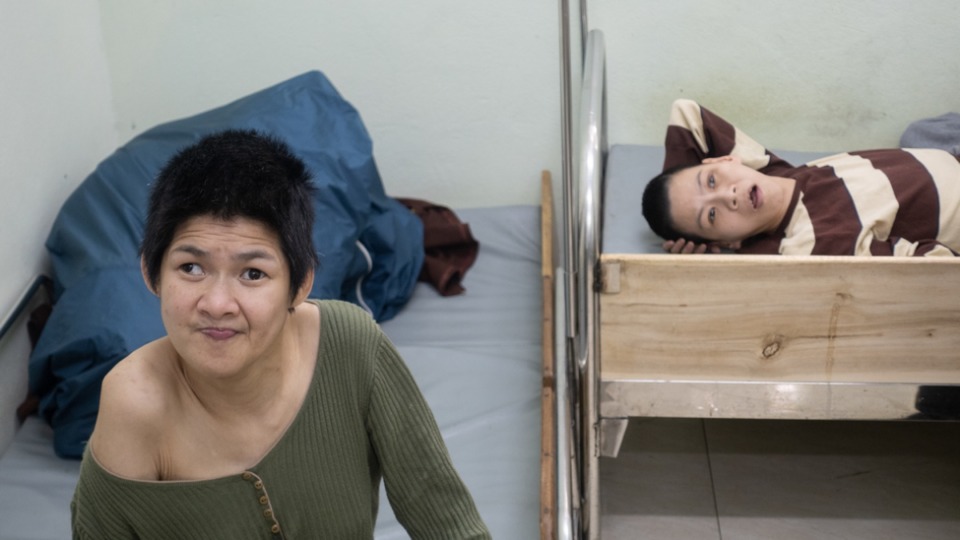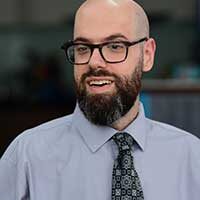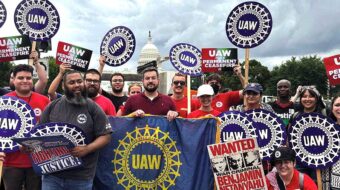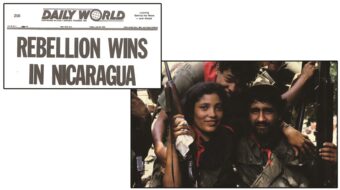
The following article is the second in a two-part series on U.S. chemical warfare in Vietnam. The first part, which can be read here, dealt with the history of Agent Orange and its use by the U.S. military in Southeast Asia. This installment covers the stories of the victims and their battle for justice.
“If the American people knew about the situation of the victims of Agent Orange, of course, we would get more support. How can anyone know about this situation and not want to offer support?” – Mr. Phạm Trương, Director of International Relations for VAVA
It has been an uphill battle for the victims of America’s chemical warfare, both in Vietnam and at home. Besides the physical and mental anguish that they all suffer, the companies and institutions that perpetrated this crime have never been held accountable in any meaningful way.
In the United States in 1985, a number of U.S. Vietnam War veterans that had suffered from the effects of Agent Orange came to a settlement with a group of chemical companies that produced the toxins for the U.S. military. The settlement, pushed for by Judge Jack Weinstein, who was presiding over the case, required the companies to create a $180 million fund to be distributed among the veterans. However, once this fund was divided between all the victims, it amounted to only a minuscule amount for each of them.
In Vietnam, the 1973 Paris Peace Accords, which ended the war, contained a clause that stated the U.S. would commit $3.25 billion in aid to help heal the wounds of war. A later promise was made for an additional $1.5 billion in aid. Neither of these promises was ever honored. Instead, in 1975 the U.S. government imposed a trade embargo on Vietnam, further damaging the war-ravished country’s economy and limiting the Vietnamese government’s ability to rebuild and aid the victims of the dioxins.
When the U.S. re-established diplomatic relations with Vietnam in 1995, there was hope that the American government would finally honor its previous commitments and help the victims of U.S. chemical warfare. These hopes were misplaced. Despite repeated promises to do more for the victims of Agent Orange/Dioxin, to this day not a single Vietnamese victim has seen a dollar of compensation from the U.S. government.
In 2004, the Vietnamese Association for Victims of Agent Orange/Dioxin (VAVA) was established by a group of Vietnamese doctors, scientists, and victims of Agent Orange. VAVA’s mission is to help care for the 4.8 million Vietnamese victims of American dioxin poisoning, as well as to represent and advocate for them in their legal campaign for justice. VAVA has stated that their legal measures are not only for the Vietnamese victims but for any victim in any country, including the U.S. veterans of the War in Vietnam.
In March, People’s World met with the director of VAVA, Senior Lt. Gen. Nguyễn Văn Rinh, and a number of the members of his staff. Mr. Rinh told the World about the history of VAVA and its ongoing search for justice for the victims of Agent Orange.
Shortly after its founding, VAVA teamed up with a group of U.S. lawyers from the National Lawyers Guild to sue the chemical companies that produced the toxic chemicals for military use, alleging that these companies were responsible for the war crimes committed with their products.
The judge hearing the case was the same Weinstein who had precided over the previous lawsuit by U.S. veterans in 1985. This time, however, Weinstein was even more sympathetic to the chemical companies and, in a shocking ruling, dismissed the case. In his decision, the judge ruled that despite the chemicals’ high toxicity, they don’t qualify as poisonous and, therefore, were not chemical weapons.
The case was appealed in February 2008 but, once again, the United States Court of Appeals for the 2nd Circuit, sitting in Manhattan, dismissed the case. The court ruled that Agent Orange/dioxin doesn’t constitute a chemical weapon and further added that Agent Orange’s main purpose was to protect American soldiers. Of course, this argument could be made about any weapon of war, despite its legality.

Later that year, in October, the case was brought to the United States Supreme Court. In January 2009, a group of U.S. veterans joined with the Vietnamese victims and brought their case against the chemical companies to the Supreme Court as well. Justice John Paul Stevens was charged with considering the cases, but for some unexplained reason, recused himself. Both cases were dismissed, and justice remained unserved.
Since the U.S. courts seemed to be solidly in the camp of the chemical companies, in 2014, a Vietnamese victim with French citizenship, Trần Tố Nga, filed a suit against the French subsidiaries of Monsanto, Dow Chemical, and other U.S. chemical companies that produced Agent Orange. Unfortunately, in 2021 the French court dismissed the case, claiming that it did not have jurisdiction in the matter. Ms. Nga’s lawyer expressed astonishment at the French court’s decision, saying it contradicted modern understanding of international law.
Beyond the legal battle, the victims suffering from the effects of dioxin poisoning still require a large amount of care and assistance; VAVA helps fill this need as well. At the moment, VAVA is operating a number of care centers at both the national and local levels in six different provinces of Vietnam. They hope to expand to a further eight provinces soon. The organization operates centers offering different forms of help to the victims depending on their specific needs. People’s World had the opportunity to visit two of these centers.
The first was the Center for Nurturing and Treatment of Agent Orange/Dioxin Victims for the Hanoi District. The center is located on the outskirts of the capital city in a peaceful area full of trees. It is the largest VAVA facility in northern Vietnam.
At the center, 103 victims with more extreme injuries are cared for by VAVA staff and volunteers. Thirty percent of those cared for at the facility are incapable of moving, while the rest suffer from extreme neurological injuries. While they have the space to care for another 30-50 victims, they need more resources to meet demand.
Next was the Social Protection Center for Agent Orange Victims. While the center was a bit closer to Hanoi, it was still far from the noise and urban chaos of the city. Here, some patients with less severe injuries are cared for by staff. At the same time, they are educated and trained for jobs. The residents of the center even grow their own tea on the premises, a fact that some of the staff and patients were very proud to share.
Finally, the World was invited to the home of Nguyễn Thanh Sơn, a war veteran and victim of Agent Orange. Mr. Sơn was mentioned in the first article in this series.

While Mr. Sơn didn’t want to elaborate on the way Agent Orange had affected his own health, the dioxin poisoning severely affected both of his children. His daughter, Nguyễn Thị Phương Thuý, the oldest of his two children, is catatonic, incapable of movement, blind, and deaf. His son, Nguyen Thanh Tung, has been blind since birth.
Mr. Sơn and his family choose to live together at home, despite the difficulty of their situation. He says that family is the most important thing, and they cannot be separated. They receive a modest apartment and a small stipend from the government but, due to limited resources and the high number of Agent Orange victims, it is not much. Mr. Sơn speaks angrily about how the U.S. government has dodged responsibility for their war crimes.
Asked whether he thought increased awareness among the American people about the conditions and needs of those suffering from the aftereffects of Agent Orange would help force the U.S. government to own up to its responsibility, Mr. Sơn replied that he thought Americans wouldn’t care about victims so far away from their own country.

Mr. Phạm Trương, International Director for VAVA, was more optimistic. “If the American people knew the full story of the victims of Agent of Orange,” he said, “of course we would receive more support. How can anyone know about this situation and not want to help?” He added that he thought one of the main problems is that the U.S. government hides the information from the American public. He further said that, because of this, it was important for Americans that are aware to share the story of the Agent Orange victims with everyone.
One certainty is that there’s much more that needs to be done. The people who live their lives with injuries caused by Agent Orange, both in Vietnam and in the U.S., are still waiting for the companies that injured them to be held responsible. Furthermore, the U.S. government needs to own up to its criminal use of chemical warfare and provide for the needs of all victims—wherever they live.
In the U.S., there is a small but passionate group of people advocating for the government to take its moral and legal responsibility for the people who are still affected by its chemical warfare. One such group is the Vietnam Agent Orange Relief & Responsibility Campaign (VAORRC). It is currently working with Rep. Barbara Lee, D-Calif., to pass the Victims of Agent Orange Relief Act, which would require the U.S. government to aid the victims of Agent Orange both at home and abroad.
This year marks 60 years since Agent Orange was first used by the U.S. military in Vietnam. For 60 years, people have suffered. For 60 years, they have struggled with few resources. For 60 years, they have waited for justice. How much longer will they have to wait?
The author would like to offer sincerest thanks to Ms. Trần Quế Lương, Assistant to the International Director of VAVA, for helping to arrange the interviews and visits to VAVA facilities. Thank also to Bùi Vũ, who helped as both a translator and photographer.












Comments